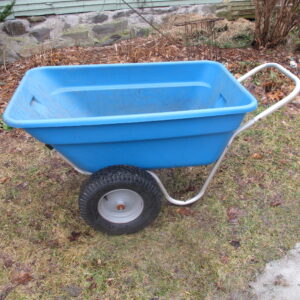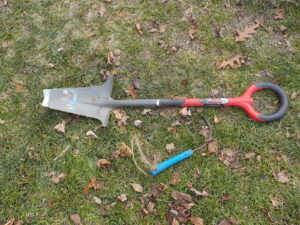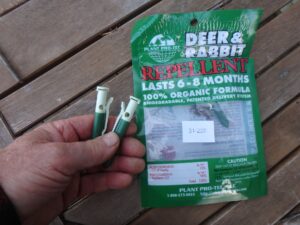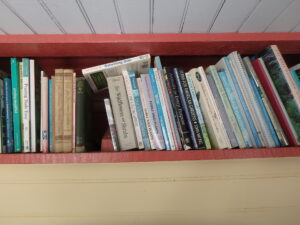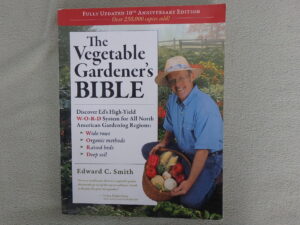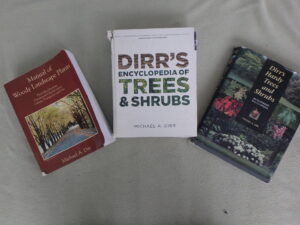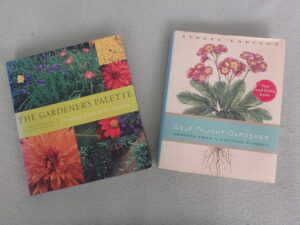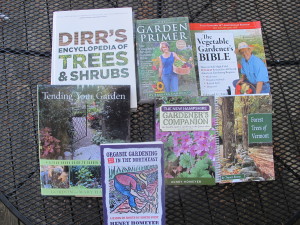Holiday Gifts for the Gardener 2023
Think about buying tickets for you and your gardening friend to a special garden, or perhaps one of the spring flower shows. This will allow the two of you to have some time together and to get some ideas about what you both can do in your gardens. One of my favorite gardens is Bedrock Garden in Lee, NH. This garden was developed by plant guru Jill Nooney and her husband, Bob Munger, over a 25 year period and recently achieved 501-(c)-3 status as a non-profit. Not only does it have a fabulous collection of plants, Jill is a sculptor and welder who has created art that is displayed in the gardens. This is truly a gem of a place and worthy of visits. Suggested donation of $15. See their website for schedules.
Adults like tools, too. For 20 years now I’ve had a Smart Cart, a well balanced two-wheel cart. The frame is made of airplane-grade tubular aluminum and the 7-cubic ft body of heavy-duty plastic. It comes either with bike-type wheels or smaller, fatter wheels capable of traversing wet areas more easily and carrying heavier loads. I chose the wide wheels, which make the cart rated for 600 pounds. The narrower wheels are rated for 400 lbs. I’ve never had a flat tire and the cart has served me well. The bin pops out if you want to wash a dog in it, or carry home manure in your Subaru. It is not inexpensive, but worth the investment.
I know most of you probably keep track of garden events on your phone – things like when you planted lettuce seeds or when your delphinium bloom. I don’t. I like an old fashioned journal I can write in with a pen. Blank books are readily available, and some companies even sell special garden journals. Gardening is a slow and thoughtful pastime and lends itself to the handwritten word.
If deer are a problem, some garlic-oil clips will add some protection in winter for your tasty trees and shrubs. I’ve had excellent luck with them, specifically with a brand called “Plant Pro-Tec Deer and Rabbit Repellent”. They come in a package of 25 for about a dollar each, and seem to last all winter. The are advertised as working for 6 to 8 months. Of course, depending on how hungry the deer are, the may not be 100% effective.
The Basics of a Garden Library
I know that many people, especially gardeners under the age of forty, use the internet to find the answers to their questions. That is fine, but the internet is full of “fake news” and spurious assertions. I do use the web, but if I want to learn about something in-depth, I reach for a book. People who write books generally write about things they know. Garden books are written by gardener
For a book on vegetable gardening there is none better than Vermont’s own Ed Smith’s The Vegetable Gardener’s Bible. With more than a million copies sold, this book goes into detail on every veggie you could grow – when and how to plant, how long seeds last, when to harvest, and much more.
Are you interested in flower gardening? My first choice of books would be Tracy DiSabato-Aust’s book, The Well-Tended Perennial Garden: Planting & Pruning Techniques. She is obviously a well-experienced gardener and designer, and one who has learned to get her flowers to re-bloom, or bloom at a shorter height, and who knows how much sun and water each needs. Staking? Dividing plants? It’s all there and more.
Trees? The most prolific and best informed expert, in my opinion, is Michael Dirr. I use his Manual of Woody Landscape Plants: Their Identification, Ornamental Characteristics, Culture, Propagation and Uses every week of the year. It has informed me about any tree or shrub I want to know about. Now in its 6th edition, it sells new for $81.80, but it is available used for much less (usually earlier editions).
Sydney Eddison is another prolific garden writer with many fine titles. Her The Gardener’s Palette: Creating Color in the Garden taught me a lot about the use of colors in the garden. Her advice is always practical and nicely explained.
Holiday Gifts for the Gardener
It’s that time of year again. Time to think about buying gifts for our loved ones. For gardeners there are so many things, selecting something is easy – from under $10 to over $500. Let me play Santa, offering you ideas to choose from – or things to avoid.
Let’s start with the no-no’s: Unless your sweetie has asked for more houseplants, don’t buy houseplants. The only exception to that might be an orchid in bloom – if she can consider it like cut flowers and jettison it after it finishes blooming. But in general, houseplants are work, and require space on a windowsill. Likewise avoid buying a do-it-yourself beehive kit or an earthworm farm for digesting the leftover lettuce that would otherwise go in the compost.
On the other hand, a truckload of good compost would be welcomed by almost any gardener. Just don’t have Santa deliver it on the driveway. Santa has to deliver to the garden, or near the garden. Composted barn scrapings are sold by most dairy farmers and garden centers, and by some lawn maintenance companies. Ask for “hot composted manure” or aged barn scrapings. The hot composted stuff should not have any viable weed seeds.
Garden gloves are good gifts. These range in price from $6.95 to $24.95. Now days you can even get them in pink. Me? I like the stretchy gloves impregnated with latex on the palms, but not on the backs, so hands can breathe.
Last summer I got a set of deer-repelling blinking lights. Quite innovative. They are solar powered, and emit a red LED light all night that scares deer or other pests. It is called Nite-Guard Solar (www.niteguard.com). You need at least 4 of these devices, so that one is facing each direction around the garden at eye-height of the deer or raccoon. In my limited use, they seem to be a big help. Of course, with heavy deer pressure, only an 8-foot fence is 100% effective.
Speaking of deer, another problem they present is Lyme disease, carried by ticks that deer and mice carry. There is a gaiter available that is impregnated with permethrin. These gaiters wrap around your pants to prevent ticks from getting to you – and to kill them if they try to attach to your pant legs. If you have a lots of ticks, these may be a great help. Available on line at www.Lymeez.com. This is a new version of one that I tried earlier, and the manufacturer assures me it will be ready for shipment by December 19.
I’m not, in general, a big fan of rototillers, but was given a little one to try out last spring. It’s called the Mantis tiller (www.mantis.com). It only weighs 24 pounds and digs down to a maximum of 10 inches. I used it for working compost into the top 6 inches of my vegetable garden and found that it did a good job. It starts easily and runs well.
My basic complaint with large tillers is that they can go down 18 inches or so, moving microorganisms from one soil depth to another. This little guy is less likely to do that. Big ones can also damage soil structure, particularly if wet.
This summer I got a sauerkraut crock from Gardeners Supply (www.gardeners.com) and like it a lot. Mine has a 1.3 gallon capacity, and comes with a kit that includes weights to keep the kraut submerged. It has a water-sealed air lock for the cover which allows the gases to be vented, but no extraneous air-borne yeasts or bacteria to enter it.
Every year I mention my favorite weeding tool, the Cobrahead Weeder (www.cobrahead.com). It is available everywhere now because it really works: like a single steel finger it can tease out long grass roots, prepare a place for a tomato seedling, or get under a big weed, allowing you to pull from above and below. If your Sweetie doesn’t have one, get one, and she’ll love you even more!
Books are always good gifts. I recently got a copy of a nice book by Vermont garden designer and author Gordon Hayward and his wife Mary called Tending Your Garden: A Year-Round Guide to Garden Maintenance. Hayward is a hands-on guy who knows a lot, and the book if full of lovely photos and sensible ideas. I also love his book, Stone in the Garden. In fact, I like all his books!
Forest Trees of Vermont by Trevor Evans is one of the nicest guides to trees I have seen. Great photos, easy-to use, it even comes with a little ruler for measuring leaves! Applicable anywhere in the Northeast. Available from Forestry Press, www.ForestryPress.com.
In general, if you like an author, any book by the same author will be good. Thus you could look for books by Michael Dirr (trees, shrubs), Barbara Damroch (general gardening), Ed Smith (vegetables) or Sydney Eddison (flowers and design). And I would be remiss if I didn’t mention my own books – they cover just about everything, but with an organic bias. My New Hampshire Gardener’s Companion is just out in an updated second edition and is relevant anywhere in New England.
Lastly, if you really don’t know what to get or are too busy to find something good, get a gift certificate to a local, family-owned garden center and let your loved pick a gift. Every serious gardener lusts after new perennials and shrubs, so why not facilitate the process with a gift certificate? And the garden centers would be happy for your business at this, a slow time of year.
Henry’s website is www.Gardening-Guy.com. Send questions to him at henry.homeyer@comcast.net.




